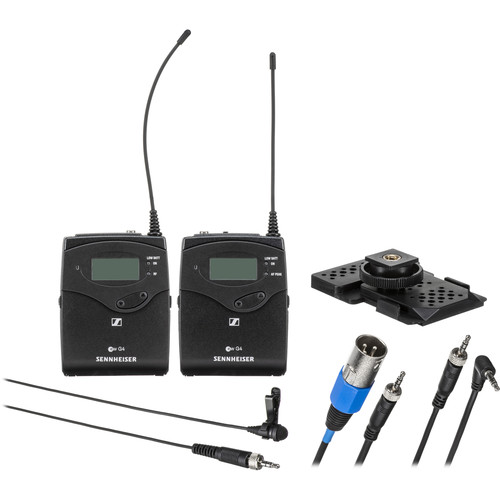Building a Studio For Recording + Streaming
1 hour ago, BLSmith2112 said:Thanks for another information filled reply, I really appreciate it!! This is starting to make more sense to me.
- $1500. 2 LAV Microphone Receiver/Transmitters.
$80. $250 Audio Mixer.- $10. Microphone Receiver to Audio Mixer Cable (guessing this will be included in #1 or #2). YES, normally included!
- $2610. 4 DSLRs (~3x Panasonic GH4 w/kit lens, + the Panasonic GH4 I currently own + power adapters so no batteries needed).
- $40. HDMI Cables.
$400. Video Mixer (To connect all 4 DSLR HDMI cables).- $900. Blackmagic ATEM Mini Pro ISO.
- $100. External USB-C HDD. No need for recording PC, just my current editing PC. Edit: I'd need a laptop or PC plugged into the ATEM Mini to monitor the 4 cameras right? Woops, so yes I'd need a custom PC or laptop.
- $5160. Total, under budget.
I don't need a video mixer because the Blackmagic ATEM Mini Pro ISO is also a mixer.
The connections would go as follows:
- Panasonic GH4 (x4) > Mini-HDMI to HDMI Cable (x4) > Blackmagic ATEM Mini Pro ISO (x1) > USB-C HDD (x1). This, with the ATEM Mini Pro ISO attached via USB to a PC will allow me to use one monitor to see, and record all (x4) GH4 DSLR feeds in real time, plus if connected through the company's network, I can also stream the output/directed video feed in 1080p at the same time. After a shoot, I can unplug the USB-C HDD from the ATEM Mini Pro, and plug it into a PC and import the footage for editing in Adobe Premiere Pro.
That sound about right?
Here is how you will connect the cameras to live streaming
4 cameras > HDMI cables (maybe you want 15-20ft cables for the distance between camera and ATEM) > ATEM Mini Pro ISO:
From the ATEM Mini Pro ISO
- you will connect a USB-C based SSD Drive (maybe multiple SSD drives using a USB Hub) for ISO recording
- Ethernet connection for live stream, as the ATEM Mini has a built in live streaming engine with presets for some services
- Computer on same network to access the ATEM Mini's setup page on a browser using the IP address of the ATEM Mini
For the audio
Microphones > Audio mixer > ATEM Mini via maybe XLR to Mini-jack line cable
If you buy something like the Sennheiser Wireless Lav kits (like the image below), in the box they usually include 2 cables for the receiver unit. Mini-jack to XLR and Mini-jack to Mini-jack cable. If you're in a studio setup, don't buy a kit where the receiver is a bodypack unit like in the image below.

Look for a kit with a rack/desktop based receiver. Check with your supplier (if you live in the US, maybe give B&H a call or online chat with their experts) that they include the right cables for connections, good antennas, and features that reduce any risk of interference. It's important that you get a good quality wireless system that can mitigate any chances of interference. Otherwise use wired mics, in which case you just Microphones > XLR cable > Audio mixer
You can even find lapel mics that have long cables or adapters to make them wired instead of wireless.

1 hour ago, BLSmith2112 said:After a shoot, I can unplug the USB-C HDD from the ATEM Mini Pro, and plug it into a PC and import the footage for editing in Adobe Premiere Pro.
YES! And as it is the ATEM Mini that has the record start/stop button, all the different video and audio files on the USB drive should have the same timecode for easy sync.
1 hour ago, BLSmith2112 said:Edit: I'd need a laptop or PC plugged into the ATEM Mini to monitor the 4 cameras right?
No, you just need a computer screen connected to the HDMI out on the back of the ATEM Mini for the multiview.
You can use any computer on the same network to access the ATEM Mini's setup/configuration control panel which is a web browser based interface. This can be any computer, no need for custom builds.
If you are not doing the ISO recording at the same time as you are live streaming, you can have a computer with OBS or other software for live streaming by connecting the ATEM to the computer by the USB-C port behind the ATEM Mini (as you are not connecting a USB drive), but you don't need a very powerful computer because the video signal encoding should be done by the hardware inside the ATEM Mini. The only thing the computer will do is connect to the streaming server.
Just to be clear, you get 2 methods to stream with the ATEM Mini
1. Stream directly using the ATEM Mini to the pre-configured platforms they have built in (Youtube, Facebook and Twitch, and if you can modify the XML files you can configure other streaming servers)
2. Connect the ATEM Mini to a computer and use OBS, Wirecast or other software to do the streaming.
As you already have an editing PC for video editing, I don't see a need for another custom PC build for the live streaming.



















Create an account or sign in to comment
You need to be a member in order to leave a comment
Create an account
Sign up for a new account in our community. It's easy!
Register a new accountSign in
Already have an account? Sign in here.
Sign In Now